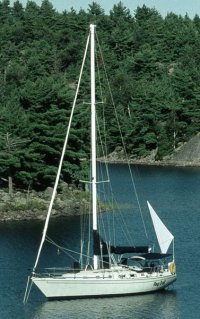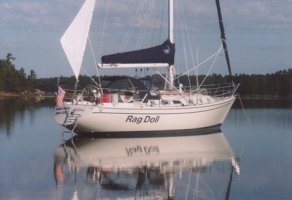Sailing at anchor
In my experience, all boats sail at anchor. Some seem to sail a little more than others. The difference in how much they sail around seems small however. Every year we spend a lot of time anchored in Elizabeth Harbor, George Town, Exuma where there can be 400 boats anchored in close quarters. Sailing at anchor is not a problem even though everyone is sailing around.
Boats with riding sails also sail about some. From my observations, riding sails, especially on sloops, don't help that much. The riding sail fills on one side the aft end swings, then the sail fills on the other side and the boat sails back.
Riding sails also interfere with aft mounted wind generators. Our friends on a Morgan Classic (Out Island 41 Sloop built by Catalina) use a riding sail and have a wind generator. The wind generator gets blanketed by the riding sail and stops spinning at each swing of the boat.
The boats that sail around the least seem to be the ones with all or nearly all chain rodes. We don't sail around any more than other boats and we usually have down 100 feet of chain and 10-20 feet of nylon (more if scope requirements demand). Most boats with all chain use a nylon snubber. Also bigger boats seem to swing about less.
The one time when we do see big differences in how various boats swing is when there's little or no wind and the tide is changing. Then, boats will lie every which way at times. This probably has to do with differences in underwater configurations especially when some boats are power boats with no keels and small rudders. It is likely that there are differences in the current flow too.
Once upon a time we owned a cruising catamaran that would sail about a lot in the wind. You could blame the light weight and the small underwater configuration but I think it had more to do with the ground tackle. On the cat, to save weight, we used a short chain and mostly nylon rode.

In my experience, all boats sail at anchor. Some seem to sail a little more than others. The difference in how much they sail around seems small however. Every year we spend a lot of time anchored in Elizabeth Harbor, George Town, Exuma where there can be 400 boats anchored in close quarters. Sailing at anchor is not a problem even though everyone is sailing around.
Boats with riding sails also sail about some. From my observations, riding sails, especially on sloops, don't help that much. The riding sail fills on one side the aft end swings, then the sail fills on the other side and the boat sails back.
Riding sails also interfere with aft mounted wind generators. Our friends on a Morgan Classic (Out Island 41 Sloop built by Catalina) use a riding sail and have a wind generator. The wind generator gets blanketed by the riding sail and stops spinning at each swing of the boat.
The boats that sail around the least seem to be the ones with all or nearly all chain rodes. We don't sail around any more than other boats and we usually have down 100 feet of chain and 10-20 feet of nylon (more if scope requirements demand). Most boats with all chain use a nylon snubber. Also bigger boats seem to swing about less.
The one time when we do see big differences in how various boats swing is when there's little or no wind and the tide is changing. Then, boats will lie every which way at times. This probably has to do with differences in underwater configurations especially when some boats are power boats with no keels and small rudders. It is likely that there are differences in the current flow too.
Once upon a time we owned a cruising catamaran that would sail about a lot in the wind. You could blame the light weight and the small underwater configuration but I think it had more to do with the ground tackle. On the cat, to save weight, we used a short chain and mostly nylon rode.


 !
!
